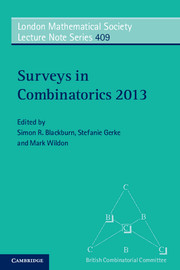Book contents
- Frontmatter
- Contents
- Preface
- 1 Graph removal lemmas
- 2 The geometry of covering codes: small complete caps and saturating sets in Galois spaces
- 3 Bent functions and their connections to combinatorics
- 4 The complexity of change
- 5 How symmetric can maps on surfaces be?
- 6 Some open problems on permutation patterns
- 7 The world of hereditary graph classes viewed through Truemper configurations
- 8 Structure in minor-closed classes of matroids
- 9 Automatic counting of tilings of skinny plane regions
- References
5 - How symmetric can maps on surfaces be?
Published online by Cambridge University Press: 05 July 2013
- Frontmatter
- Contents
- Preface
- 1 Graph removal lemmas
- 2 The geometry of covering codes: small complete caps and saturating sets in Galois spaces
- 3 Bent functions and their connections to combinatorics
- 4 The complexity of change
- 5 How symmetric can maps on surfaces be?
- 6 Some open problems on permutation patterns
- 7 The world of hereditary graph classes viewed through Truemper configurations
- 8 Structure in minor-closed classes of matroids
- 9 Automatic counting of tilings of skinny plane regions
- References
Summary
Abstract
A map, that is, a cellular embedding of a graph on a surface, may admit symmetries such as rotations and reflections. Prominent examples of maps with a ‘high level of symmetry’ come from Platonic and Archimedean solids. The theory of maps and their symmetries is surprisingly rich and interacts with other disciplines in mathematics such as algebraic topology, group theory, hyperbolic geometry, the theory of Riemann surfaces and Galois theory.
In the first half of the paper we outline the fundamentals of the algebraic theory of regular and orientably regular maps. The second half of the article is a survey of the state-of-the-art with respect to the classification of such maps by their automorphism groups, underlying graphs, and supporting surfaces. We conclude by introducing the notion of ‘external symmetries’ of regular maps, going well beyond automorphisms, and discuss the corresponding ‘super-symmetric’ maps.
Introduction
Groups are often studied in terms of their action on the elements of a set or on particular objects within a structure. Examples of such situations are abundant and we mention here just a few. Since Cayley's time we know that every group can be viewed as a group of permutations on a set. The study of group actions on vector spaces gave rise to the vast area of representation theory. Investigation of automorphism groups of field extensions generated challenges such as the Inverse Galois Problem. In low-dimensional topology, group actions on trees and on graphs in general led to important findings regarding growth of groups.
Information
- Type
- Chapter
- Information
- Surveys in Combinatorics 2013 , pp. 161 - 238Publisher: Cambridge University PressPrint publication year: 2013
References
Accessibility standard: Unknown
Why this information is here
This section outlines the accessibility features of this content - including support for screen readers, full keyboard navigation and high-contrast display options. This may not be relevant for you.Accessibility Information
- 16
- Cited by
